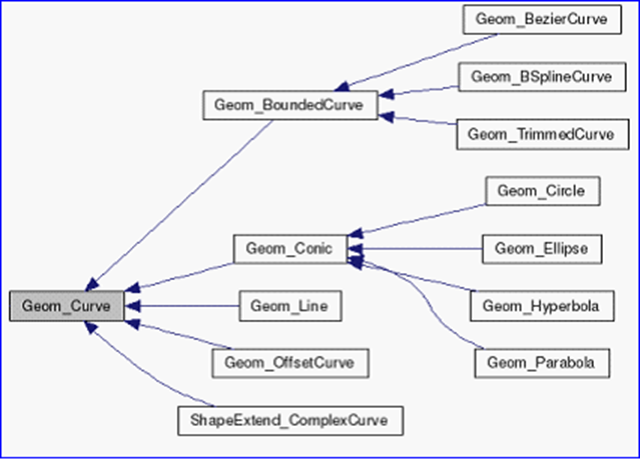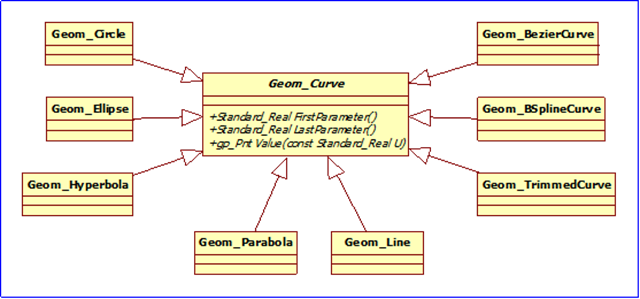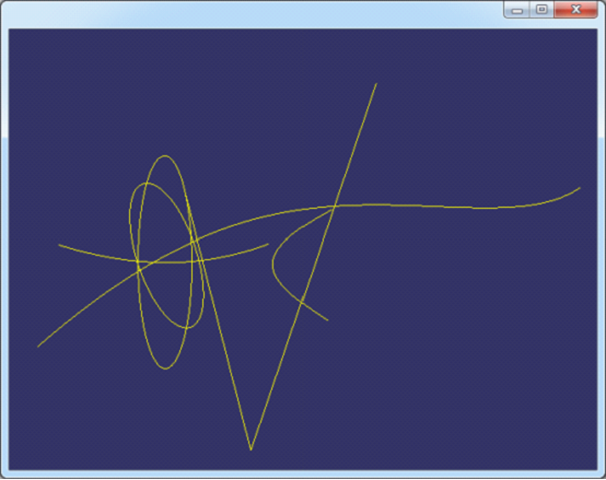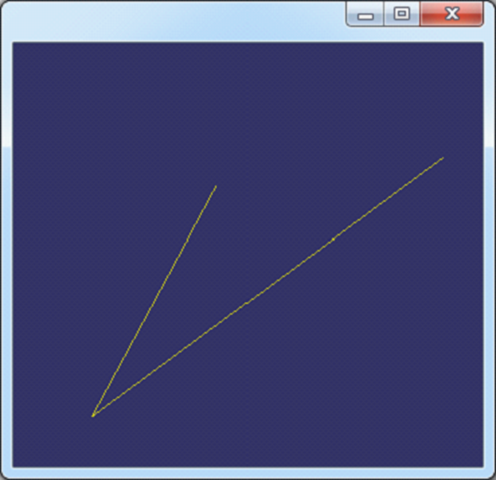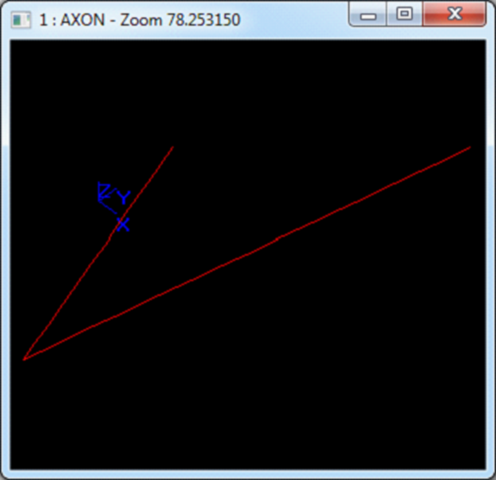在OpenSceneGraph中绘制OpenCascade的曲线
Draw OpenCascade Geometry Curves in OpenSceneGraph
摘要Abstract:本文简要说明OpenCascade中几何曲线的数据,并将这些几何曲线在OpenSceneGraph中绘制出来。
关键字KeyWords:OpenCascade、Geometry Curve、OpenSceneGraph、B-Spline、NURBS
一、引言 Introduction
结合《BRep Format Description White Paper》对OpenCascade中的几何数据结构有详细的介绍。OpenCascade中BRep格式中的曲线总共分为九种,不过有二维三维之分:
1.直线 Line
2.圆 Circle
3.椭圆 Ellipse
4.抛物线 Parabola
5.双曲线 Hyperbola
6.Bezier曲线 Bezier Curve
7.B-Spline曲线 B-Spline Curve
8.裁剪曲线 Trimmed Curve
9.偏移曲线 Offset Curve
曲线的几何数据都有一个抽象基类Geom_Curve,类图如下所示:
Figure 1.1 Geometry curve class diagram
抽象基类Geom_Curve有几个纯虚函数FirstParameter()、LastParameter()、Value(),根据这几个虚函数,就可以计算曲线上对应参数U的值。类图如下图所示:
Figure 1.2 Geom_Curve Inherited class diagram
每种曲线都对那些纯虚函数进行实现,使计算曲线上点的方式统一。
二、程序示例 Code Example
根据抽象基类Geom_Curve的几个纯虚函数:
1.FirstParameter();
2.LastParameter();
3.Value(u);
利用多态可将曲线上点都以统一的方式计算出来,并使用GL_LINE_STRIP绘制出来。示例程序如下所示:
2 * Copyright (c) 2013 eryar All Rights Reserved.
3 *
4 * File : Main.cpp
5 * Author : eryar@163.com
6 * Date : 2013-08-09 18:09
7 * Version : 1.0v
8 *
9 * Description : Draw OpenCascade Geometry Curves in OpenSceneGraph.
10 *
11 */
12
13 // OpenSceneGraph library.
14 #include < osgDB / ReadFile >
15 #include < osgViewer / Viewer >
16 #include < osgViewer / ViewerEventHandlers >
17 #include < osgGA / StateSetManipulator >
18
19 #pragma comment(lib, " osgd.lib " )
20 #pragma comment(lib, " osgDbd.lib " )
21 #pragma comment(lib, " osgGAd.lib " )
22 #pragma comment(lib, " osgViewerd.lib " )
23
24 // OpenCascade library.
25 #include < TColgp_Array1OfPnt.hxx >
26 #include < TColStd_Array1OfReal.hxx >
27 #include < TColStd_Array1OfInteger.hxx >
28
29 #include < Geom_Circle.hxx >
30 #include < Geom_Ellipse.hxx >
31 #include < Geom_Hyperbola.hxx >
32 #include < Geom_Parabola.hxx >
33 #include < Geom_BezierCurve.hxx >
34 #include < Geom_BSplineCurve.hxx >
35
36 #pragma comment(lib, " TKernel.lib " )
37 #pragma comment(lib, " TKMath.lib " )
38 #pragma comment(lib, " TKG3d.lib " )
39
40 // Curve Segment Delta.
41 const double CURVE_SEGMENT_DELTA = 0.01 ;
42
43 /*
44 * @brief Build geometry curve of OpenCascade.
45 */
46 osg::Node * buildCurve( const Geom_Curve & curve)
47 {
48 osg::ref_ptr < osg::Geode > geode = new osg::Geode();
49 osg::ref_ptr < osg::Geometry > linesGeom = new osg::Geometry();
50 osg::ref_ptr < osg::Vec3Array > pointsVec = new osg::Vec3Array();
51
52 gp_Pnt point;
53 double dFirst = curve.FirstParameter();
54 double dLast = curve.LastParameter();
55
56 Precision::IsNegativeInfinite(dFirst) ? dFirst = - 1.0 : dFirst;
57 Precision::IsInfinite(dLast) ? dLast = 1.0 : dLast;
58
59 for ( double u = dFirst; u <= dLast; u += CURVE_SEGMENT_DELTA)
60 {
61 point = curve.Value(u);
62
63 pointsVec -> push_back(osg::Vec3(point.X(), point.Y(), point.Z()));
64 }
65
66 // Set the colors.
67 osg::ref_ptr < osg::Vec4Array > colors = new osg::Vec4Array;
68 colors -> push_back(osg::Vec4( 1.0f , 1.0f , 0.0f , 0.0f ));
69 linesGeom -> setColorArray(colors. get ());
70 linesGeom -> setColorBinding(osg::Geometry::BIND_OVERALL);
71
72 // Set the normal in the same way of color.
73 osg::ref_ptr < osg::Vec3Array > normals = new osg::Vec3Array;
74 normals -> push_back(osg::Vec3( 0.0f , - 1.0f , 0.0f ));
75 linesGeom -> setNormalArray(normals. get ());
76 linesGeom -> setNormalBinding(osg::Geometry::BIND_OVERALL);
77
78 // Set vertex array.
79 linesGeom -> setVertexArray(pointsVec);
80 linesGeom -> addPrimitiveSet( new osg::DrawArrays(osg::PrimitiveSet::LINE_STRIP, 0 , pointsVec -> size()));
81
82 geode -> addDrawable(linesGeom. get ());
83
84 return geode.release();
85 }
86
87 /* *
88 * @breif Build geometry curve of OpenCascade.
89 */
90 osg::Node * buildScene()
91 {
92 osg::ref_ptr < osg::Group > root = new osg::Group();
93
94 // 1. Build circle curve.
95 Geom_Circle circle(gp::YOZ(), 1.0 );
96
97 root -> addChild(buildCurve(circle));
98
99 // 2. Build ellipse curve.
100 Geom_Ellipse ellipse(gp::ZOX(), 1.0 , 0.3 );
101
102 root -> addChild(buildCurve(ellipse));
103
104 // 3. Build Hyperbola curve.
105 Geom_Hyperbola hyperbola(gp::XOY(), 1.0 , 0.6 );
106
107 root -> addChild(buildCurve(hyperbola));
108
109 // 4. Build parabola curve.
110 Geom_Parabola parabola(gp::ZOX(), 1.0 );
111
112 root -> addChild(buildCurve(parabola));
113
114 // 5. Build Bezier curve.
115 TColgp_Array1OfPnt poles( 1 , 4 );
116 poles.SetValue( 1 , gp_Pnt( - 1 , - 1 , 0 ));
117 poles.SetValue( 2 , gp_Pnt( 1 , 2 , 0 ));
118 poles.SetValue( 3 , gp_Pnt( 3 , 0 , 0 ));
119 poles.SetValue( 4 , gp_Pnt( 4 , 1 , 0 ));
120 Geom_BezierCurve bezierCurve(poles);
121
122 root -> addChild(buildCurve(bezierCurve));
123
124 // 6. Build BSpline curve.
125 TColgp_Array1OfPnt ctrlPnts( 1 , 3 );
126 TColStd_Array1OfReal knots( 1 , 5 );
127 TColStd_Array1OfInteger mults( 1 , 5 );
128
129 ctrlPnts.SetValue( 1 , gp_Pnt( 0 , 1 , 0 ));
130 ctrlPnts.SetValue( 2 , gp_Pnt( 1 , - 2 , 0 ));
131 ctrlPnts.SetValue( 3 , gp_Pnt( 2 , 3 , 0 ));
132
133 knots.SetValue( 1 , 0.0 );
134 knots.SetValue( 2 , 0.25 );
135 knots.SetValue( 3 , 0.5 );
136 knots.SetValue( 4 , 0.75 );
137 knots.SetValue( 5 , 1.0 );
138
139 mults.Init( 1 );
140
141 Geom_BSplineCurve bsplineCurve(ctrlPnts, knots, mults, 1 );
142
143 root -> addChild(buildCurve(bsplineCurve));
144
145 return root.release();
146 }
147
148 int main( int argc, char * argv[])
149 {
150 osgViewer::Viewer myViewer;
151
152 myViewer.setSceneData(buildScene());
153
154 myViewer.addEventHandler( new osgGA::StateSetManipulator(myViewer.getCamera() -> getOrCreateStateSet()));
155 myViewer.addEventHandler( new osgViewer::StatsHandler);
156 myViewer.addEventHandler( new osgViewer::WindowSizeHandler);
157
158 return myViewer.run();
159 }
因抛物线和双曲线的FirstParameter()和LastParameter()为负无穷和正无穷,所以对其进行处理,只输出了部分曲线。
程序效果如下图所示:
Figure 2.1 OpenCascade Geometry Curves in OpenSceneGraph
三、结论 Conclusion
OpenCascade的几何数据使用还是很方便的,只要将相应的曲线构造出来之后,计算曲线上的点使用函数Value()即可,还可计算相应参数处的微分值等。
通过理解《BRep Format Description White Paper》,可将BRep文件中数据导入OpenCascade中与上面实现的程序进行对比,结果正确。如下图所示:
Figure 3.1 B-Spline in OpenSceneGraph
Figure 3.2 B-Spline in OpenCascade Draw
PDF Version: Draw OpenCascade Geometry Curves in OpenSceneGraph
